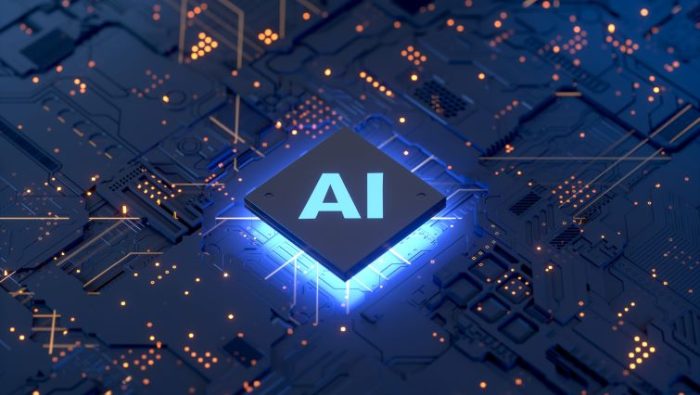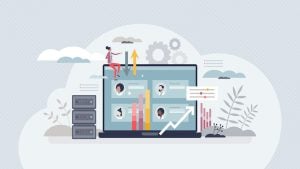5 Game-Changing Applications of AI in Human Resources
 Publié le 28 October 2021
Publié le 28 October 2021
Take advantage of the latest technological advances to move your business toward a successful future with 5 game-changing applications of AI in human resources.
Once the stuff of sci-fi movies, artificial intelligence (AI) is now becoming central to many aspects of human life. AI cars can drive you around autonomously, guided by navigation systems that will avoid traffic and facial recognition allows you to unlock your phone. We even have chatbots to deal with customer complaints or queries.
The applications of AI are seemingly limitless. This is why AI is now finding itself at the center of businesses across all departments. Forbes claims that in 2021 over a third of businesses are already using some sort of AI.
This article will look at 5 game-changing applications of AI in human resources. But before we begin, let’s take a closer look at artificial intelligence.
What Exactly Is AI?
Before we look at some of the applications of AI in human resources, it’s important to understand what AI means.
The Britannica online dictionary describes artificial intelligence as “the ability of a digital computer or robot to perform tasks usually associated with intelligent beings.” Once a fantasy, now a reality. In recent years, technological advancements have seen computers and robots with artificial intelligence capabilities improve rapidly.
The ability for AI to think, learn, and make decisions allows them to perform complex tasks only previously possible by humans. AI can now undertake reasoning, problem-solving, speech recognition, and sensory perception.
These benefits have seen AI become central to businesses across all departments, saving them heaps of human time and effort. AI has also revolutionized startups by allowing new small businesses to automate tasks without having a strong workforce.
Benefits of AI in HR
Somewhat ironically, one department benefitting hugely from AI is human resources.
The use of AI in human resources is on the rise. In the next few years, 47% of HR departments are expected to utilize AI in some capacity. This is unsurprising given the number of ways AI can help HR departments by increasing efficiency.
In times where big-data rules, integrating AI into your processes is a great way to free up time and take a load off your staff members. Why let your lovely employees stress over collecting and analyzing piles of data when AI can do it in minutes? And with IoT automation connecting networks and devices, it’s easier than ever.
Tasks commonly performed in HR departments such as recruitment processes, scanning through resumes, scheduling meetings, responding to emails, and general admin tasks, can all be completed in minutes rather than hours.
By utilizing AI and automating processes, HR departments are left with more time for the things that require human interaction and empathy such as meetings, appraisals, and mentoring. Remember, AI is not looking to replace human workers, but rather aid them and make their jobs easier.
5 Game-Changing Applications of AI in Human Resources
Let’s now look at some of the ways AI can help HR departments.
Sourcing New Recruits
Finding and recruiting the right candidate for the job takes time and effort. Your HR team’s recruitment scheduling involves trawling through hiring websites, making phone calls to agencies and recruiters, and searching internal and external databases.
Too often, time constraints and pressure mean decisions have to be made on a hunch. The problem? This doesn’t always work out. Would you let a doctor operate on you solely because they thought maybe it was for the best? Of course not. They would have conducted multiple tests and thoroughly researched all other options before making this decision.
The same rings true for recruiting new employees. By utilizing AI in the recruitment process, businesses can reliably automate many functions to make sure they’re choosing the best options while saving time in the process.
Reducing Bias
Equality and fairness are of paramount importance in the hiring process of the 21st century. Unfortunately, humans can be inadvertently influenced by external factors that should have no impact on a candidate’s suitability.
Human behavior expert Kimberly Giles cites the “subconscious bias” as one of the main reasons businesses make bad hiring decisions all the time. She observes that employers tend to hire candidates that have similar traits to themselves, but this doesn’t necessarily make them suitable for the role.
Then there’s the “unconscious bias” which sees people making preferences for people of their own race, gender, age, or education and employment background. The solution? Artificial intelligence.
AI can be used to create algorithms that avoid human biases by removing characteristics that don’t affect suitability. The result is a diversified pool of potential candidates that are suited to the role, rather than suited to your own judgments and opinions.
Streamline New Employees’ Onboarding Process
Being the new person can be stressful for both the newbie and the HR departments who have to oversee their integration into the team. But utilizing AI during the onboarding process, this can help streamline and improve the experience.
Firstly, AI programs can show new staff some of the routine procedures of your organization. This can be done via a video call app or chatbot and prevents the need for HR staff to be physically present.
Training can also be provided via AI rather than face-to-face meetings. By inserting a new employee’s current skill set and awareness, AI can track their progress and see how they’re developing. Training can then be optimized and tailored for the individual.
Intelligent bots can also be used to handle frequently asked questions regarding, policies, contracts, and other queries.
By utilizing AI in the above ways to make the onboarding process easier, HR teams are left with extra time for the tasks that require human intervention.
Improve Employee Retention and Decrease Departures
It’s common for people to become unhappy at work and want to leave or find new challenges. Whatever the reason, AI can help with retention and departure rates.
Whilst AI won’t stop people from becoming unhappy, it can flag staff members who may be underperforming or whose punctuality and commitment levels have dropped. These systems can then redirect employees to a development meeting or even find a better-suited role elsewhere in the business.
Employees are likely to feel more content knowing these systems are in place to help them. In turn, happiness and retention levels rise. Sometimes people don’t speak up about their feelings, but this is a way to highlight such cases.
AI can also determine which employees look like leaving imminently. Screening can monitor computer activity such as keystrokes, browsing history, and emails to find out who wants out. AI will spot patterns of behaviour that go against the norm for happy employees. In effect, AI may actually spot an unhappy employee before they even know it themselves.
Automating Administrative Tasks
Most HR departments undertake laborious and repetitive tasks daily. There are emails, phone calls, documents, contracts, policies, performance reviews, managing holidays, and anything else in between to deal with. These repetitive, “low-level” tasks can take time and energy away from your staff. These days, intelligent SAP RPA can be used to automate the most mundane of daily tasks and free up time.
In letting AI take over the tasks that can be soul-destroying and monotonous, not only does efficiency and production rise but so do staff happiness levels. The question is no longer how to use excel, but rather how to automate excel.
No longer do staff need to input data one by one for hours on end while wishing they were somewhere else.
Final Thoughts
As we’ve seen, there are several benefits to integrating AI into your HR department. By automating processes for maximum efficiency, time and resources are freed up and your staff can focus on the tasks that need human intervention and interaction.
With AI use on the rise, now is the time to get up to speed with all the ways this sophisticated technology can help you and your business.







